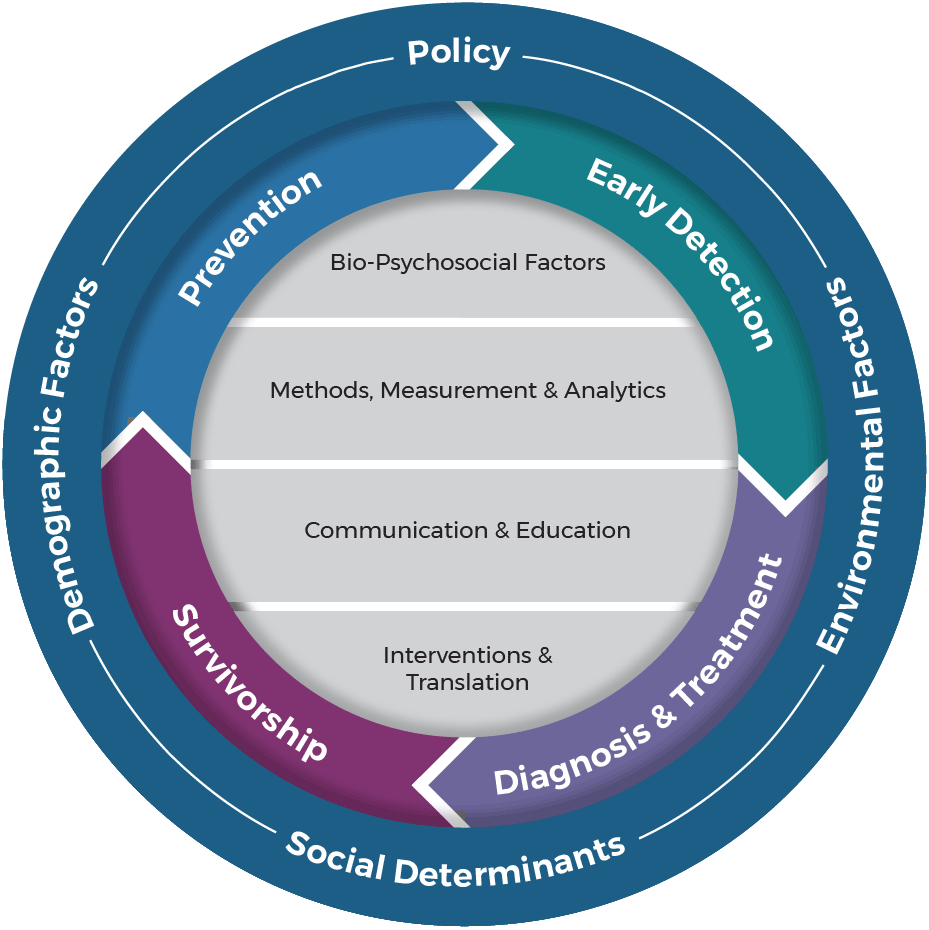Behavioral Research in Cancer Control

NIH has supported behavioral medicine research for 40 years through funded research, conferences, priority setting, and training programs. Over those four decades, behavioral medicine research has played a critical role in responding to major public health challenges, including, most notably, the HIV/ AIDS crisis and tobacco control and prevention.
Research on tobacco use is regarded as one of the most significant public health success stories, and NCI—along with the NIH National Institute on Drug Abuse (NIDA) and the National Heart, Lung, and Blood Institute (NHLBI)—has been particularly involved in funding groundbreaking tobacco control research over the decades, as well as supporting the development of evidence-based interventions, ranging from smoking cessation interventions to environmental changes and policies shown to prevent smoking and tobacco use (Czajkowski et al., J Behav Med, 2019).
Behavioral Research Scientific Priorities

At NCI, DCCPS was established in 1997 and included the Behavioral Research Program (BRP) as one of its major programmatic areas. Creating a program specifically focused on behavioral research in cancer control reflected the understanding that what was once a niche area of research had evolved to become a respected and essential part of scientific research, now integrated into virtually every aspect of the cancer control continuum, from prevention to end-of-life care. In the two decades since the establishment of the DCCPS BRP, the division has taken a leadership role on such NIH-level behavioral research efforts as the NIH Obesity Task Force, NIH Common Fund Programs with a behavioral research component, and international tobacco control research. The BRP grant portfolio at NCI has grown steadily, including 244 grants in FY 2018 compared with 186 in FY 1998. Behavioral research informs virtually all research conducted in the division’s other programs, including smoking and lung cancer modeling, epidemiology cohorts, patient-centered communication, clinical trial enrollment, and behavioral barriers to implementing evidenced-based interventions.
The Cancer Control Continuum
Focus
Etiology
- Environmental factors
- Genetic factors
- Gene-environment interactions
- Medication (or pharmaceutical) exposure
- Infectious agents
- Health behaviors
Prevention
- Tobacco control
- Diet
- Physical activity
- Sun protection
- HPV vaccine
- Limited alcohol use
- Chemoprevention
Detection
- Pap/HPV testing
- Mammography
- Fecal occult blood test
- Colonoscopy
- Lung cancer screening
Diagnosis
- Shared and informed decision making
Treatment
- Curative treatment
- Non-curative treatment
- Adherence
- Symptom management
Survivorship
- Coping
- Health promotion for survivors
Crosscutting Areas
- Communications
- Surveillance
- Health Disparities
- Decision Making
- Implementation Science
- Health Care Delivery
- Epidemiology
- Measurement
Behavioral research priorities at NCI include basic behavioral and psychological science; interventions in cancer control areas such as tobacco use, diet and energy balance, and sun protection; and processes and effects of communication and consumer health informatics. Behavioral risk factors of interest include adherence to cancer-related medical and behavioral regimens, behavioral genetics, diet, energy balance, obesity, physical activity and sedentary behavior, sun safety and tanning, and tobacco use. Additionally, emerging topics of interest include social media and misinformation, integrative data and data analysis, cancer and aging, alcohol use, sleep and circadian dysfunction, and the use of e-cigarettes and other vaping devices in a rapidly evolving scientific and policy context.
Behavioral research plays a pivotal role in cancer control, providing solutions to significant clinical and public health challenges. NCI and DCCPS will continue to champion the contributions of behavioral research through the stewardship of our robust behavioral research portfolio and advocating for inclusion of behavioral research within larger biomedical initiatives.
Signature Behavioral Research Initiatives

Cancer Centers Cessation Initiative (C3I)
C3I was created in 2017 as part of the Cancer Moonshot℠. It has provided resources to 42 NCI-Designated Cancer Centers to develop and implement sustainable tobacco cessation treatment programs to systematically address tobacco cessation with cancer patients. The Coordinating Center at the University of Wisconsin Carbone Cancer Center supports funded sites by ensuring that science-based smoking cessation treatment services are integrated into clinical care, providing technical assistance, and serving as the hub of knowledge integration.
Centers of Excellence in Cancer Communication Research (CECCR) Initiative
The interdisciplinary CECCR initiative was the centerpiece of NCI’s Extraordinary Opportunity in Cancer Communication, reflecting NCI’s recognition that effective communication can and should be used to narrow the gap between discovery and application and to reduce health disparities. The funded Centers provided essential infrastructure to facilitate rapid advances in knowledge about cancer communication, translate theory and programs into practice, and train health communication scientists.
Centers for Population Health and Health Disparities (CPHHD)
In conjunction with NHLBI, the National Institute of Environmental Health (NIEHS), the National Institute on Aging (NIA), and the Office of Behavioral and Social Sciences Research (OBSSR), NCI funded ten centers to investigate cancer and heart disease inequities. The funding was designed to foster transdisciplinary collaborations among investigators from biological, medical, sociological, and public health fields and to increase the rigor and impact of science that addresses factors associated with health disparities.
Collaborative Research on Addiction at NIH (CRAN)
CRAN is a trans-NIH partnership among NIAAA, NIDA, and NCI created in 2013 to foster research in poly- or multiple substance abuse. It funds the Adolescent Brain Cognitive Development (ABCD) study, the largest long-term study of brain development and child health in the United States. They will recruit approximately 10,000 children ages 9–10 years and follow them into early adulthood, enabling researchers to understand the many factors that influence brain, cognitive, social, and emotional development.
National Collaborative on Childhood Obesity Research (NCCOR) 
NCCOR is a collaboration among the Centers for Disease Control and Prevention (CDC), DCCPS NIH, the Robert Wood Johnson Foundation, and the US Department of Agriculture (USDA). The goal is to facilitate the reduction of childhood obesity in America by coordinating funding and sharing insights and expertise to advance research.
-
NCCOR Measures Registry and User Guides

The registry was launched in 2011 and is a searchable database of diet and physical activity measurement tools relevant to childhood obesity research. It includes information on more than 750 measures extracted from approximately 550 peer-reviewed publications. It is designed to standardize use of common measures and research methods for childhood obesity research at individual, community, and population levels. In 2017, four user guides—individual diet, individual physical activity, food environment, and physical activity environment—were released through a strategic funding alliance between NCCOR and The JPB Foundation to complement the NCCOR Measures Registry. In 2019, interactive learning modules were introduced to assist users with choosing the best measures across the four domains of the Measures Registry.
NCCOR Catalogue of Surveillance Systems

The catalogue, which also launched in 2011, is a free web-based resource that links to over 100 publicly available US datasets relevant to childhood obesity for researchers and practitioners. Each profile provides key information on the surveillance system, such as key variables, data access and cost, and geocode/linkage information. Datasets include information on obesity-related health behaviors, determinants, outcomes, policies, and environmental factors.
Science of Team Science (SciTS)
SciTS is a quickly growing field that focuses on understanding and handling barriers to and facilitators of large-scale research, training, and translational activities. DCCPS Director Robert Croyle and BRP staff Kara Hall and Amanda Vogel recently edited the book Strategies for Team Science Success, which highlights evidence-based principles and practical guidance for conducting cross-disciplinary team science.
Smokefree.gov
The Smokefree.gov Initiative (SFGI) provides smokers who want to quit with free, evidence-based smoking cessation information and on-demand support. The SFGI includes six mobile-optimized websites, nine SMS text programs, two smartphone apps, and six social media platforms, available in English and Spanish. Special programs exist for women, teens, veterans, and people older than age 60.
Smoking Cessation at Lung Examination (SCALE)
The SCALE Collaboration is an NCI-sponsored initiative, led by funded investigators and NCI staff, to share data and methods to enable cross-project research on smoking cessation interventions in the setting of low-dose computed tomography (LDCT) lung cancer screening. NCI serves as the Coordinating Center for the SCALE Collaboration to support communication, dissemination, and data sharing among eight funded research projects. Members of the SCALE Collaboration developed a set of publicly available measures that they considered important to share for research in this setting, known as the SCALE Special Measures Collection ![]() .
.
Smoking Cessation Interventions among People Living with HIV
NCI recently awarded six grants under the RFAs Improving Smoking Cessation Interventions among People Living with HIV (PLH). These awards support research to systematically test existing evidence-based smoking cessation interventions and/or develop and evaluate adaptations of evidence-based smoking cessation interventions for PLH in the US. The funded research will address crosscutting areas of health disparities and behavioral and social sciences research, and inform dissemination efforts to reduce the incidence of tobacco-related disease and death in PLH.
State and Community Tobacco Control (SCTC) Research Initiative
SCTC was created to increase collaboration among researchers and projects and to promote innovative research to benefit state and community tobacco control efforts. Research projects focused on media and marketing strategies, community and social norms, and policies related to secondhand smoke, tax and pricing.
Tobacco Centers of Regulatory Science (TCORS)
TCORS is a joint NIH/Food and Drug Administration (FDA) initiative designed to establish a comprehensive research agenda in tobacco regulatory science. Since 2013, TCORS has funded a total of 23 institutions. TCORS 2.0, the latest iteration, is designed to develop scientific evidence across seven domains, including the toxicity of tobacco smoke, influences of tobacco marketing, and the impact of potential FDA regulatory actions.
New to TCORS 2.0 is a rapid response program that allows investigators to examine novel, time-sensitive research questions identified by NIH and FDA.
Transdisciplinary Research on Energetics and Cancer (TREC) Centers
TREC fosters collaboration across multiple disciplines and projects, from the biology, genomics, and genetics of energy balance to behavioral, sociocultural, and environmental influences on nutrition, physical activity, weight, energetics, and cancer risk. The initiative has trained 156 early-career researchers through annual transdisciplinary workshops on energy balance and cancer. To date, more than 1,100 peer-reviewed publications have resulted from TREC.
Transdisciplinary Tobacco Use Research Centers (TTURC)
The TTURCs, funded by NCI, NIDA, and the National Institute on Alcohol Abuse and Alcoholism (NIAAA), were designed to increase the number of investigators from multiple disciplines whose work focuses on basic and applied tobacco research as part of transdisciplinary teams. The initiative also aimed to increase the number of novel, evidence-based tobacco control interventions.
Trans-NIH Consortium: Randomized Controlled Trials of Lifestyle Weight Loss Interventions for Genome-Wide Association Studies
In October 2015, NCI issued an RFI to identify randomized control trials of weight loss interventions that collected biospecimens suitable for a large collaborative genome-wide study. Principal investigators from the identified studies have formed a consortium to (1) explore the contribution of genetics to variation in intentional weight loss and weight maintenance; (2) identify challenges and strategies for pooling existing resources; and (3) discuss potential approaches for harmonizing phenotypes of interest.
Methods Development and Public Use Data
for Behavioral Research

Accumulating Data to Optimally Predict Obesity Treatment (ADOPT) Core Measures Project
The ADOPT Core Measures Project is an effort led by NHLBI, with co-funding from NCI and OBSSR, to identify key biological, psychological, behavioral, and environmental variables and measures related to weight loss to determine potential predictors of successful weight loss and maintenance. The goal of ADOPT is to facilitate identification of predictors of response to obesity treatment, enabling more precise targeting of obesity-related interventions and potentially more effective treatments for obesity. BRP is currently funding an ADOPT subproject to develop objective environmental measures and make them available to researchers on the NCI website.
Automated Self-Administered 24-Hour (ASA24®) Dietary Assessment Tool
ASA24 is a free web-based tool for epidemiologic, interventional, behavioral, or clinical research that enables multiple automatically coded, self-administered 24-hour recalls and food records. Since ASA24 was released in 2009, over 6,000 studies have registered to use it, and as of November 2019, over 500,000 recall or record days had been collected.
ASA24–2018 was funded by NCI, NHLBI, NIAAA, the National Institute of Diabetes and Digestive and Kidney Diseases (NIDDK), and the NIH OBSSR and Office of Dietary Supplements.
Classification of Laws Associated with School Students (CLASS)
CLASS uses a scoring system to classify state laws for physical education and nutrition in schools as they compare to national standards and recommendations. CLASS data can help users monitor, classify, and evaluate the strength of school physical activity and nutrition policies across states and over time.
Diet History Questionnaire (DHQ)
The DHQ is a free web-based food frequency questionnaire for use with adults 19 years or older. The most recent version, DHQ III, can be used by researchers, clinicians, and educators to assess food and dietary supplement intakes.
Family Life, Activity, Sun, Health, and Eating (FLASHE) Study
FLASHE is an NCI-funded cross-sectional, internet-based study on psychosocial, generational (parent–adolescent), and environmental correlates of cancer-preventive behaviors. The survey collected data on diet, physical activity, sleep, sun safety, and tobacco use. FLASHE was designed to support individual and dyadic analyses among a total of 1,479 dyads who completed all study procedures.
Food Attitudes and Behavior (FAB) Survey Project
NCI staff developed the FAB Survey to evaluate multiple factors that may be related to adult fruit and vegetable consumption. The survey measured both conventional constructs (e.g., self-efficacy, social support) and novel ones (e.g., shopping patterns, views on vegetarianism) among a sample of 3,397 adults.
Grid-Enabled Measures (GEM) Database
GEM is a publicly available dynamic and interactive website conceptualized by NCI and developed by Westat, Inc., that provides behavioral and social science measures organized by theoretical constructs (e.g., anxiety, depression). The platform promotes the use of standardized measures for theoretically based constructs and facilitates more efficient research through collaboration and data sharing.
Health Information National Trends Survey (HINTS)
HINTS is a large-scale, nationally representative survey that collects data related to the American public’s use of cancer-related information. All data are available for public use. To date, 41 HINTS briefs have been created on topics ranging from trust in health information sources to cancer information-seeking behaviors. As of September 2019, 519 articles had been published using HINTS data.
Healthy Eating Index (HEI)
The HEI is a measure of diet quality that can be used to assess how well a set of foods aligns with key recommendations of the Dietary Guidelines for Americans. The HEI is also used to monitor changes in dietary patterns and to evaluate nutrition interventions and consumer nutrition education programs.
Researchers from NCI and USDA collaborate to update the HEI based on updates to the Dietary Guidelines for Americans.
The Interactive Diet and Activity Tracking in AARP (IDATA) Study Data
IDATA is a methodologic study of device-based, internet-based, and conventional self-report measures assessing physical activity and diet in epidemiologic studies. The instruments include 24-hour diet and time-use recalls, diaries, questionnaires, screeners, accelerometers, inclinometers, and urine biomarkers. Data were collected between 2012 and 2013 from 1,082 participants.
National Health Interview Survey (NHIS) Cancer Control Supplement (CCS)
NHIS serves as the main source of US data on a broad range of health topics. DCCPS sponsors an annual Cancer Control Supplement to the NHIS, which is administered to the sample adult in the selected household. The CCS focuses on issues pertaining to knowledge, attitudes, and practices of cancer-related health behaviors, screening, and risk assessment.
National Health and Nutrition Examination Survey (NHANES)
NHANES is a program of studies designed to assess the health and nutritional status of adults and children in the United States. The survey is unique in that it combines interviews and physical examinations.
NCI supports modules in the NHANES that provide data useful for monitoring dietary intake and physical activity.
Patient-Reported Outcomes Measurement Information System (PROMIS®) 
PROMIS is a set of person-centered measures that evaluates and monitors physical, mental, and social health in adults and children. It can be used with the general population and with individuals living with chronic conditions.
SEER-CAHPS Linked Data Resource
The SEER-CAHPS data set is a resource for quality-of-care research based on a linkage between SEER cancer registry data and CMS Medicare Consumer Assessment of Healthcare Providers and Systems (CAHPS®) patient surveys. These data provide a rich opportunity for analyses of Medicare beneficiaries’ experiences with their care at various stages of the cancer care continuum.
SEER-Medicare Health Outcomes Survey (SEER-MHOS) Linked Data Resource
The SEER-MHOS linked database is designed to improve understanding of the health-related quality of life of cancer patients and survivors enrolled in Medicare Advantage health plans. The database contains clinical, quality-of-life, socioeconomic, demographic, and other information. SEER-MHOS is sponsored by NCI and CMS. The SEER-MHOS data files became publicly available to external investigators in December 2010.
Surveillance, Epidemiology, and End Results (SEER) Data Connections
The SEER program collects data on cancer cases from a variety of locations and sources throughout the US to support efforts to reduce cancer burden. SEER supports multiple research activities such as quality of care studies, the Residual Tissue Repository Program, and SEER-linked databases, which link SEER data with other large data sources. Every year, the SEER Program releases updated cancer statistics and a report providing an update of rates for new cancer cases and deaths, as well as trends for the most common cancers in the US. Most recently, in April 2019, SEER incidence data (1975–2016) were released along with the SEER Cancer Statistics Review report, providing an overview of the most recent cancer incidence, mortality, survival, prevalence, and lifetime risk statistics. In May 2019, the Annual Report to the Nation on the Status of Cancer was jointly issued by CDC, NCI, the North American Association of Central Cancer Registries (NAACCR), and the American Cancer Society (ACS).
The Tobacco Use Supplement to the Current Population Survey (TUS-CPS)
TUS-CPS is an NCI-sponsored survey of tobacco use that has been administered as part of the US Census Bureau’s Current Population Survey every 3 to 4 years since 1992–1993. Data can be used to study long-term trends in tobacco use, cessation attempts, and tobacco- related policies, among other topics. Most recently, data from 1992–2015 were harmonized into a single dataset that is available for use.
Updated Compendium of Physical Activities 
The Adult Compendium of Physical Activities, an NCCOR product, was developed in 1993 and has been updated twice, most recently in 2011. This project was supported by the University of Arizona and NCI to standardize the assignment of Metabolic Equivalent (MET) intensities in physical activity questionnaires in epidemiologic studies among adults. Similar to the Adult Compendium, the Youth Compendium provides the estimated energy costs (youth METs) associated with 196 common activities in which youth participate. The data can be used by a variety of audiences, including researchers, health care professionals, teachers, coaches, and fitness professionals for research, public health policy making, education, and interventions to encourage physical activity in youth.
Synthesis of Behavioral Research Findings

Tobacco Control Monograph Series
This series was established by NCI in 1991 to provide ongoing and timely information about emerging public health issues in smoking and tobacco use control. Highlights from the 22 published volumes (so far) include the following:
- Monograph 13: Risks Associated with Smoking Cigarettes with Low Tar Machine-Measured Yields of Tar and Nicotine, October 2001
- Monograph 19: The Role of the Media in Promoting and Reducing Tobacco Use, August 2008
- Monograph 21: The Economics of Tobacco and Tobacco Control (a collaboration between NCI and the World Health Organization), December 2016
Special Journal Issues
DCCPS staff and grantees have edited, organized, and contributed to a number of special issues that have aimed to advance NCI research priorities, highlight NCI-developed resources and resulting findings, and much more. The following is a selection.
- The Accumulating Data to Optimally Predict OBESITY Treatment (ADOPT) Core Measures Project
 , Obesity, April 2018
, Obesity, April 2018 - Advances in Cancer and Brain, Behavior, and Immunity: A Decade of Progress, Brain, Behavior, and Immunity, March 2013
- Cancer and Psychology, American Psychologist
 , February–March 2015
, February–March 2015 - Cancer Prevention and Control in the Changing Communication Landscape
 , JNCI Monographs, December 2013
, JNCI Monographs, December 2013 - The Family Life, Activity, Sun, Health, and Eating (FLASHE) Study: Insights Into Cancer-Prevention Behaviors Among Parent–Adolescent Dyads, American Journal of Preventive Medicine,
June 2017 - Multimorbidity in Health Psychology and Behavioral Medicine Research, Health Psychology, September 2019
Other Reports of Interest
- Improving Cancer-Related Outcomes with Connected Health: A Report to the President of the United States from the President’s Cancer Panel, 2016
- DCCPS staff and grantees participated in a series of workshops on connected health and cancer, which aimed to identify ways to optimize the development and use of technologies to promote cancer prevention, enhance the experience of cancer care for patients and providers, and accelerate progress in cancer research. This report presents the resulting objectives and action items.
- Oncology Informatics: Using Health Information Technology to Improve Processes and Outcomes in Cancer
 , 2016
, 2016 - Co-edited by a recent BRP branch chief and featuring chapters by staff and grantees
from across DCCPS, NCI, and NIH, this textbook provides a resource for health care providers and professionals, designers, and researchers interested in the development, implementation, and utilization of informatics tools to improve cancer care. - Geospatial Approaches to Energy Balance and Breast Cancer
 , 2019
, 2019
- This book, co-edited by a DCCPS staff member and featuring chapters by many division-funded grantees, familiarizes readers with novel methods, tools, and approaches applicable to geospatial studies on cancer.
Cancer Control Publications (CC Pubs)
Read about more behavioral research findings from work conducted by DCCPS staff, grantees, and contractors in this searchable database of over 35,000 publications.
Emerging Areas of Behavioral Research Emphasis in Cancer Control

Cancer and Aging
As the US population ages, the number of cancer survivors will continue to increase exponentially. DCCPS is committed to developing a robust area of research to investigate the intersection between cancer and aging, with the goal of improved understanding about the short- and long-term effects of cancer and its treatment on aging trajectories among pediatric and adult cancer survivor populations. The Cancer and Accelerated Aging: Advancing Research for Healthier Survivors initiative represents a collaboration of NCI, the National Institute on Aging (NIA), and representatives from cancer research institutions throughout the country. It seeks to identify scientific research needs related to the aging consequences of cancer and cancer treatment and to build a transdisciplinary research portfolio to optimize healthy aging for cancer survivors. The initiative held two think tank meetings with experts in the field to determine how best to 1) measure aging and identify aging phenotypes in cancer survivors, and 2) identify strategies to prevent or remediate cancer- and treatment-associated aging (Guida et al., J Natl Cancer Inst, 2019; Guida et al., J Geriatr Oncol, 2019, in press). In addition, DCCPS established the Perspectives on Cancer and Aging: Arti Hurria Memorial Webinar Series as a platform to broadly disseminate the work of researchers dedicated to cancer and aging research. This quarterly series is dedicated to the legacy of Dr. Hurria, a BRP grantee and collaborator and pioneer in the fields of geriatrics and oncology. In addition, DCCPS staff were the initial facilitators of the Trans-NCI Cancer and Aging Coordinating Committee (CACC) to integrate and coordinate all NCI cancer and aging extramural program activities, and to facilitate extramural program interactions and collaborations with NIA and the Trans- NIH GeroScience Interest Group.
Communication of Genetic Information
Recent advances in genetic and genomic technologies have revolutionized our ability to prevent, detect, and treat cancer, adding increasing complexity to patient-clinician communication and patient engagement in research. Based on the Blue Ribbon Panel’s recommendations to advance the goals of the Cancer MoonshotSM, NCI established several initiatives to address those recommendations. Two initiatives related to the communication of genetic information were 1) Prevention and Early Detection of Hereditary Cancers and 2) Establish a Network for Direct Patient Engagement. As part of these initiatives, DCCPS issued multiple funding opportunities. Communication and Decision Making for Individuals with Inherited Cancer Syndromes is a request for applications (RFA) to develop, test, and evaluate interventions and implementation approaches, or adapt existing approaches, to improve patient/provider/family risk communication and decision making for individuals and families with an inherited susceptibility to cancer so that they can make informed clinical risk management decisions. Participant Engagement and Cancer Genome Sequencing (PE-CGS) (RFA-CA-19-045, RFA-CA-19-046) is a set of RFAs to support the PE-CGS Network, which will include several research centers and a coordinating center. The purpose of the network is two-fold: It will promote and support research on direct engagement of cancer patients and posttreatment cancer survivors as participants in cancer research, and it will use such approaches for rigorous cancer genome sequencing projects addressing important knowledge gaps in the genomic characterizations of tumors in areas such as rare cancers, highly lethal cancers, cancers with early age of onset, cancers with high disparities, and cancers in understudied populations. Additionally, BRP commissioned a scoping review of recent published literature on communication of cancer-related genetic and genomic testing information, which identified areas of strong research emphasis and also revealed gaps ripe for further research (Kaphingst et al., Genet Med, 2019).
Alcohol and Cancer
Alcohol is a well-established human carcinogen, and mounting evidence points to a link between alcohol and cancers of the oral cavity, pharynx, larynx, colon/rectum, esophagus, liver, stomach, and female breast. There is also some evidence that alcohol may increase the risk of lung, pancreatic, and skin cancers. Additionally, alcohol use can have detrimental effects on cancer treatment, leading to prolonged recovery, increased surgical procedures, higher health care costs, and more. Although momentum is building to better address alcohol consumption in cancer prevention and control, at least half of both Americans and the global population do not consider alcohol a risk factor for cancer. DCCPS seeks to engage the research community on challenges related to communication and awareness, alcohol drinking and outcomes in cancer patients and survivors, and mechanisms linking alcohol and cancer. Activities to advance interest in this research area include presentations at national and international scientific conferences and development of several publications about awareness of the link between alcohol consumption and cancer (e.g., Klien et al., JAMA, in press, 2019). In September 2018, DCCPS hosted a webinar, “Alcohol and Cancer in the United States,” featuring Noelle K. LoConte, MD, lead author of the Alcohol and Cancer statement by the American Society of Clinical Oncology, published in November 2017.
Sleep
The role of sleep in cancer prevention and control is an important but understudied topic. Possible mechanisms linking sleep and cancer include immune functioning and inflammatory processes, which can be modulated by sleep quality, timing, and duration. Research also suggests that the psychological and cognitive sequalae of poor sleep may influence decisions across the cancer continuum, from decisions to engage in unhealthy behaviors that may increase cancer risk (e.g., low physical activity, poor diet, and alcohol consumption) to decisions about treatment, palliative care, information sharing, and genetic testing.
DCCPS has identified sleep quality and chronotype (i.e., morning vs. evening types) as important areas for further understanding, especially in relation to their influence on addiction and tobacco use among other co-occurring behaviors. We seek to further understand the state of sleep research as it relates to cancer prevention and control, enhance our understanding of the relationship between sleep and cancer, as well as support the development and implementation of cancer prevention and control interventions for healthy populations and cancer patients and survivors.
Geospatial Research
The growth of geographic information science and the application of geospatial tools and data visualization techniques have advanced our understanding of cancer prevalence, etiology, and treatment. In addition, there is greater recognition that a multilevel approach is needed to address the complex nature of cancer. Progress in this area and its importance in enhancing cancer control efforts at the community level resulted in a 2016 NCI-sponsored conference on Geospatial Approaches to Cancer Control and Population Sciences, attended by almost 300 investigators. The conference led to the development of a focus issue of the journal Cancer Epidemiology, Biomarkers & Prevention, titled “CEBP Focus: Geospatial Approaches to Cancer Control and Population Sciences ![]() .” Moreover, a recent review of publications arising from NCI-Designated Cancer Centers indicates a rapid increase in the number of papers involving geospatial approaches, especially since 2000 (Korycinski et al., Cancer Causes Control, 2018). Recently, DCCPS issued administrative supplements for geospatial, multilevel, and contextual approaches in cancer control and population sciences (https://grants.nih.gov/grants/guide/notice-files/NOT-CA-19-029.html).
.” Moreover, a recent review of publications arising from NCI-Designated Cancer Centers indicates a rapid increase in the number of papers involving geospatial approaches, especially since 2000 (Korycinski et al., Cancer Causes Control, 2018). Recently, DCCPS issued administrative supplements for geospatial, multilevel, and contextual approaches in cancer control and population sciences (https://grants.nih.gov/grants/guide/notice-files/NOT-CA-19-029.html).
Electronic Nicotine Delivery Systems (e.g., e-cigarettes)
With the proliferation of electronic nicotine delivery systems (ENDS) (such as e-cigarettes and other vaping devices) in the marketplace and a rise in youth e-cigarette use to epidemic levels, research is critically needed to answer many important questions about these products and the public health implications of their use. Specifically, we need to better understand how to monitor the rapidly evolving marketplace of these and other tobacco products. Regarding health effects, we need more research on the short- and long-term health effects of ENDS and patterns of use among youth and adults over time, especially their use in combination with other tobacco products. To better understand and address the public health challenge presented by youth ENDS use, we need research about the determinants of use, particularly risk and protective factors, and how youth smoking prevention and cessation research may inform the development of interventions to reduce youth ENDS use.
DCCPS encourages research on the effects of ENDS on individual and population health through participation in two trans-NIH PARs (PAR-18-845, PAR-18-847) and through several Tobacco Regulatory Science Program (TRSP) funding announcements. In addition, investigators may submit ENDS-related research proposals through the omnibus announcements. Currently, NCI is funding 40 grants with a primary or secondary focus on ENDS research. These projects investigate a broad range of topics, including ENDS toxicity and health impact, perceptions of ENDS’ risks and harms, ENDS use by adolescents and young adults, the influence of ENDS on other tobacco-use behaviors, and the impact of ENDS product marketing and promotion. Several grants focus on understanding trajectories of ENDS use over time, especially concurrent and multiple tobacco product use (dual or polyuse). Other important areas of study include contextual factors that influence ENDS use, such as promotion of ENDS through social media and the impact of tobacco control policies. In 2018, DCCPS co-sponsored and co-led an NIH-FDA workshop on ENDS Measurement, which focused on identifying gaps and developing a consensus on measures for ENDS device characteristics and ENDS use behavior.
Social Media
The Health Communication and Informatics Research Branch within BRP has spearheaded many NIH efforts to study changing patterns of health information exchange brought on by technology and new media. Through funding opportunity announcements such as Innovative Approaches to Studying Cancer Communication in the New Media Environment (PAR-18-638, PAR-18-639) and Using Social Media to Understand and Address Substance Use and Addiction (RFA-CA-14-008, RFA-CA-14-009), DCCPS is advancing the science and methodology in this emerging field and its impact on knowledge, attitudes, and behavior.
As social media becomes more ubiquitous as a source of information, we are seeing the rise of inaccurate or false health information on social media platforms. This dynamic is occurring in an era of low trust in social institutions, including the medical system. This confluence of factors—pervasive social media, rampant misinformation, and lack of trust in expert sources—is creating new challenges in effectively communicating evidence-based information to patients and the general public. DCCPS is interested in supporting innovative and multidisciplinary research in this area. In August 2018, it held a working group meeting to develop a research agenda for understanding and addressing cancer-related misinformation on social media platforms, and that meeting has resulted in several publications. DCCPS also will publish a special issue about health misinformation on social media, in collaboration with the American Journal of Public Health.
Data Integration
Integrative Data Analysis (IDA) methods can be used to study cancer control and behavioral risk factors for cancer, including tobacco and alcohol use, diet and physical activity, UV and environmental exposures, sleep, and medical adherence to screening and vaccine uptake. By merging multiple iterations of survey, cohort, or experimental data, or linking data by matching entity (e.g., person, hospital, school) or geocodes (e.g., zip code, county or state, or another geographic identifier), IDA-related research can yield efficient and productive research that reduces costs, bridges behavioral research with other disciplines, and enhances longitudinal analyses and assessment of small populations. Recently, DCCPS issued administrative supplements for IDA to extend research to answer novel cancer prevention and control questions (https://grants.nih.gov/grants/guide/notice-files/NOT-CA-18-087.html).
Behavioral Research to Inform and Respond to Public Policy
DCCPS supports science that helps to inform policies and programs aimed at preventing, detecting, and treating cancer. The division’s long-standing history of collaborating across the NIH and other parts of the Department of Health and Human Services (HHS), as well as other agencies, makes it uniquely suited to support research that provides policy makers with the practical evidence they need to shape and respond effectively to national cancer-related efforts.

This section provides examples of the division’s behavioral research contributions related to public policy, illustrating its vital role in developing a comprehensive base of scientific evidence for policy makers and public health practitioners.
Tobacco Control
NCI’s Tobacco Control Research Branch (TCRB), within BRP, leads and collaborates on research and disseminates evidence-based findings to prevent, treat, and control tobacco use in order to create a world free of tobacco use and related cancer and suffering. DCCPS’ work informs numerous areas of tobacco control-related policy; included here are just a few examples.
- DCCPS-supported research shows that significantly increasing the excise tax and price of tobacco products is the single most consistently effective tool for reducing tobacco use (Monograph 21).
- A current TCRB-led funding opportunity, US Tobacco Control Policies to Reduce Health Disparities, supports projects that address cancer health disparities in tobacco use in the United States.
- The NCI-sponsored Tobacco Use Supplement to the Current Population Survey (TUS-CPS) is conducted every 3 to 4 years as part of the US Census Bureau’s CPS. The TUS-CPS serves as a key source of national- and state-level data on tobacco use behavior, attitudes, and policies in the United States. (See page 8.)
- DCCPS-funded research has contributed to the strong evidence base regarding effective treatments and interventions for tobacco dependence. This research informs CMS as it develops policies regarding smoking cessation as a covered benefit among recipients of Medicare and Medicaid, and the Federal Employee Health Benefit Program continues to offer smoking cessation programs and medications to its beneficiaries without co-payments or coinsurance.
- NCI collaborated with the World Health Organization on Monograph 21: The Economics of Tobacco and Tobacco Control. The monograph examines the current research and evidence regarding the economics of tobacco control and has helped to direct future research and inform tobacco prevention and control programs and policies around the world.
- The 2009 Family Smoking Prevention and Tobacco Control Act granted FDA the authority to regulate the manufacture, marketing, and distribution of tobacco products in order to protect public health. Within the framework of the Tobacco Control Act, the NIH and FDA formed the Tobacco Regulatory Science Program (TRSP) partnership to establish a comprehensive research agenda in tobacco regulatory science.
- The State and Community Tobacco Control (SCTC) Research Initiative was developed to increase collaboration among researchers and practitioners and to promote innovative research that benefits state and community tobacco control efforts. SCTC supported studies that addressed important understudied aspects of tobacco use and exposure in the United States while also examining the effectiveness of state and community tobacco control policy and media interventions.
A Healthier Generation
Evidence continues to show that lifestyle behaviors such as diet, physical activity, obesity/overweight, and energy balance can influence the chance of developing cancer, even after accounting for other factors such as stress, environment, or smoking. DCCPS works with numerous federal and non-federal partners to help set national objectives for promoting health and preventing disease. The division also supports individual and community-based intervention research that explores the effect of lifestyle behaviors in order to help inform ongoing public health efforts across the US and the world.
DCCPS co-leads the Healthy People 2020 Cancer Chapter Workgroup with CDC. The Healthy People 2020 initiative provides science-based, 10-year national objectives for promoting health and preventing disease. DCCPS’ Health Information National Trends Survey (HINTS)—nationally representative data routinely collected about the American public’s use of cancer-related information—is used to evaluate the success of Healthy People goals.
DCCPS also has helped to inform the Dietary Guidelines for Americans (DGAs), which are jointly issued and updated every 5 years by USDA and HHS. The guidelines form the basis for federal nutrition policy and provide authoritative dietary advice to promote health and reduce risk for major chronic diseases. DCCPS-supported researchers developed methodologies for estimating usual dietary intake distributions and identifying sources of key dietary constituents including added sugars, and the resulting data have proven to be critical for the recent and upcoming versions of the guidelines.
In addition, DCCPS worked with researchers at USDA to develop the Healthy Eating Index (HEI), a measure of dietary quality, which assesses conformance to the DGAs and has been used in hundreds of studies, including the evaluation of USDA’s multi-billion- dollar food assistance programs. The division also has supported the 2007 Food Attitude and Behaviors (FAB) Survey and, since 2003, the Classification of Laws Associated with School Students, which provides an empirical and regularly updated scoring system used by researchers, policy makers, and the public to evaluate and track changes in state laws related to school nutrition.
DCCPS also funds a number of research initiatives that focus on enhancing the research base for physical activity and its effects on cancer, including mechanisms of physical activity behavior change, physical activity in women with infants, and the protective effects of physical activity on adolescent tobacco use prevention. In addition, DCCPS is leading efforts to examine the role of physical activity in modulating cancer recurrence and survival outcomes through its mechanisms, initiatives, and support of a clinical trial to test the hypothesis that reducing obesity will increase survival time.
DCCPS’ work also helps to inform the Physical Activity Guidelines for Americans, which describe the types and amounts of physical activity that offer substantial health benefits. The guidelines serve as the primary, authoritative voice of the federal government for evidence-based guidance on physical activity, fitness, and health. The second edition of the guidelines was released in 2018.
The DCCPS-supported Transdisciplinary Research on Energetics and Cancer (TREC) initiative fostered transdisciplinary research to elucidate underlying biological mechanisms of obesity and cancer, explore new biomarkers, develop potential for genetics/ genomics to advance individualized treatment, expand translational research focus, add particular emphasis on cancer survivors, and strengthen use and integration of theoretical constructs.
DCCPS also supports evaluation research of programs and time-sensitive policies that affect diet, physical activity, and weight at the population level. The funded grants have covered a wide range of policies, such as examining the effects of the built environment on physical activity and evaluating whether the development of supermarket or food hubs will improve eating and shopping behaviors.
Health Equity
Achieving health equity (the “attainment of the highest level of health for all people”), eliminating disparities, and improving the health of all groups are overarching goals of Healthy People 2020. These also have been a major thrust of all of the programs within DCCPS since the division’s inception. The broad area of health equity and disparities has benefitted significantly from transdisciplinary research teams in identifying the factors that contribute to and exacerbate inequities. Social determinants of health, conditions in the environments in which people are born, live, learn, work, play, worship, and age that affect a wide range of health, functioning, and quality-of-life outcomes and risks, are mostly responsible for health inequities, the unfair and avoidable factors in health status seen within and between countries.
The division has a very broad-based perspective on funding and conducting research on adverse health conditions that exist among specific population groups—groups delineated by gender, age, race, ethnicity, education, income, social class, disability, geographic location, or sexual orientation—to inform prevention and intervention programs. Current funding opportunities such as the TCRB funding opportunity mentioned on page 16, Research to Improve Native American Health, and Collaborative Minority Health and Health Disparities Research with Tribal Epidemiology Centers support cancer research to better understand and ultimately to eliminate health disparities in these populations. Looking to the future, we hope to increase our investment in developing interventions for underserved and disadvantaged populations through a complement of scientific activities that will reduce the burden of these factors, inform policy, and improve overall health.

